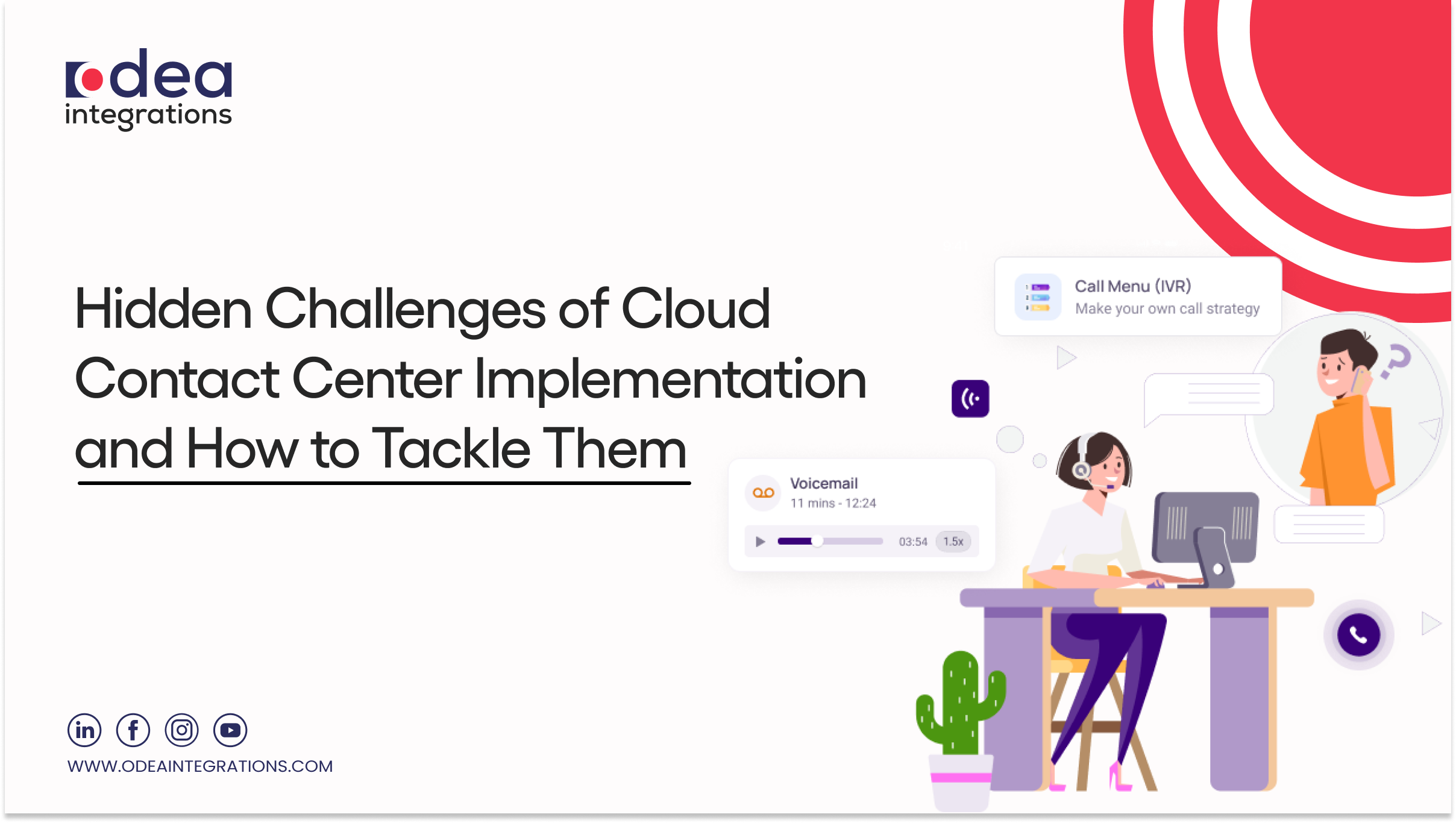Migrating to a cloud contact center offers numerous benefits, from greater scalability to improved customer experiences. However, many organizations face challenges that can sabotage the success of their implementation. A cloud contact center is a web-based platform that allows businesses to manage customer interactions across various channels, such as phone, email, chat, and social media, all from a centralized system hosted in the cloud.
In this blog, we’ll explore the top issues that undermine cloud contact center implementations and provide practical solutions to overcome them.
Complex Organizational Strategies
Cloud contact center implementations often fail due to overly complex organizational strategies. When different departments and stakeholders have conflicting priorities, the migration process can become muddled, causing delays and misalignment in goals.
How to Fix It: Simplify and align your organizational strategies with a clear roadmap. Ensure all departments involved—from IT to customer support—are on the same page, with shared objectives and timelines. This unified approach prevents conflicting priorities from derailing your project.
Visionless Leadership
Leaders who fail to provide a clear vision for cloud migration create confusion and resistance among teams. When employees don’t understand the long-term benefits of the transition, motivation plummets, and the project loses momentum.
How to Fix It: Leadership should craft and communicate a compelling vision for the cloud contact center’s role in achieving broader company goals. By outlining the specific benefits, such as enhanced customer experience and cost savings, leadership can generate buy-in from all levels of the organization, ensuring a smoother transition.
Complex Processes
Migrating legacy processes to a cloud platform can expose inefficiencies. These complex, outdated workflows often clash with the flexibility required in a cloud-based system, slowing down implementation and creating operational bottlenecks.
How to Fix It: Before migrating, streamline and simplify your processes. Take the opportunity to reengineer outdated workflows, eliminating unnecessary steps and automating repetitive tasks. A leaner, more agile set of processes will adapt better to the cloud, maximizing its potential.
IT Bottlenecks
Despite the cloud reducing infrastructure demands, IT bottlenecks can still arise. Limited resources, slow decision-making, and inadequate technical expertise can delay the migration process, leading to frustration and missed deadlines.
How to Fix It: Ensure that IT teams are well-equipped and have the necessary bandwidth to manage the migration. Collaboration between business and IT teams is key, as is the option to outsource certain tasks to external cloud specialists who can provide expertise and speed up the process.
Security Concerns
Many organizations delay or abandon cloud contact center migrations due to fears around data security. With sensitive customer information at stake, a security breach can be catastrophic.
How to Fix It: Collaborate with your cloud provider to establish strong security protocols, including encryption, multi-factor authentication, and regular security audits. Ensuring compliance with industry-specific regulations, such as GDPR or HIPAA, will give you confidence in the security of your cloud system.
Overlooking Stakeholder Engagement
Failure to engage all relevant stakeholders early in the implementation process often leads to resistance and confusion. When key personnel, like customer service agents and managers, feel left out of decision-making, they are more likely to resist new technologies and workflows.
How to Fix It: Involve all stakeholders from the outset. Organize workshops, focus groups, and communication sessions where employees can provide feedback and share their concerns. This builds trust and reduces resistance, ensuring a smoother transition.
Lack of Clear KPIs
Many businesses fail to define clear Key Performance Indicators (KPIs) before starting their cloud contact center project. This lack of clear success metrics results in vague goals and the inability to measure the return on investment (ROI) effectively.
How to Fix It: Define measurable KPIs upfront, such as customer satisfaction scores (CSAT), first call resolution (FCR), or average handling time (AHT). Regularly track these metrics to assess progress and tweak the implementation plan when needed.
Employee Resistance and Training Gaps
The human element is one of the most significant barriers to a successful cloud contact center implementation. Without adequate training and change management, employees may resist the new technology, slowing adoption and limiting the benefits of the migration.
How to Fix It: Develop a comprehensive training and change management plan that helps employees transition smoothly. Provide ongoing support, clear instructions, and an open forum to address any concerns or fears they may have about the new system.
Focusing Solely on Cost Savings
While moving to the cloud can reduce costs, focusing solely on cost savings can lead to poor decision-making. Opting for the cheapest solution may result in a lack of essential features or insufficient support, which could hurt your business in the long run.
How to Fix It: Look beyond cost when evaluating cloud platforms. Focus on value, scalability, and the ability to enhance customer experience. Choose a platform that balances affordability with advanced features, ensuring long-term success.
Conclusion: Ensuring a Smooth Cloud Transition
Cloud contact centers have the potential to transform your business, but only if implemented correctly. By addressing common pitfalls like IT bottlenecks, security concerns, and employee resistance, you can ensure a smoother transition and realize the full benefits of the cloud. Key takeaways include:
- Align organizational strategies and communicate a clear vision
- Streamline processes before migration
- Address security concerns proactively
- Engage all stakeholders throughout the implementation process
- Set clear KPIs to measure success
- Invest in comprehensive employee training and change management
- Focus on long-term value, not just cost savings
At Odea Integrations, we specialize in guiding businesses through seamless cloud contact center implementations. Our expertise in integrating systems, ensuring security, and driving employee adoption guarantees that your transition is successful and delivers real ROI.
Our services include:
- Implementation Services
- Consulting Services
- Cloud Migration Services
- Support Services
- Managed Services
Don’t let hidden challenges derail your cloud contact center implementation. Partner with Odea Integrations for a smooth, successful transition that transforms your customer service capabilities.





